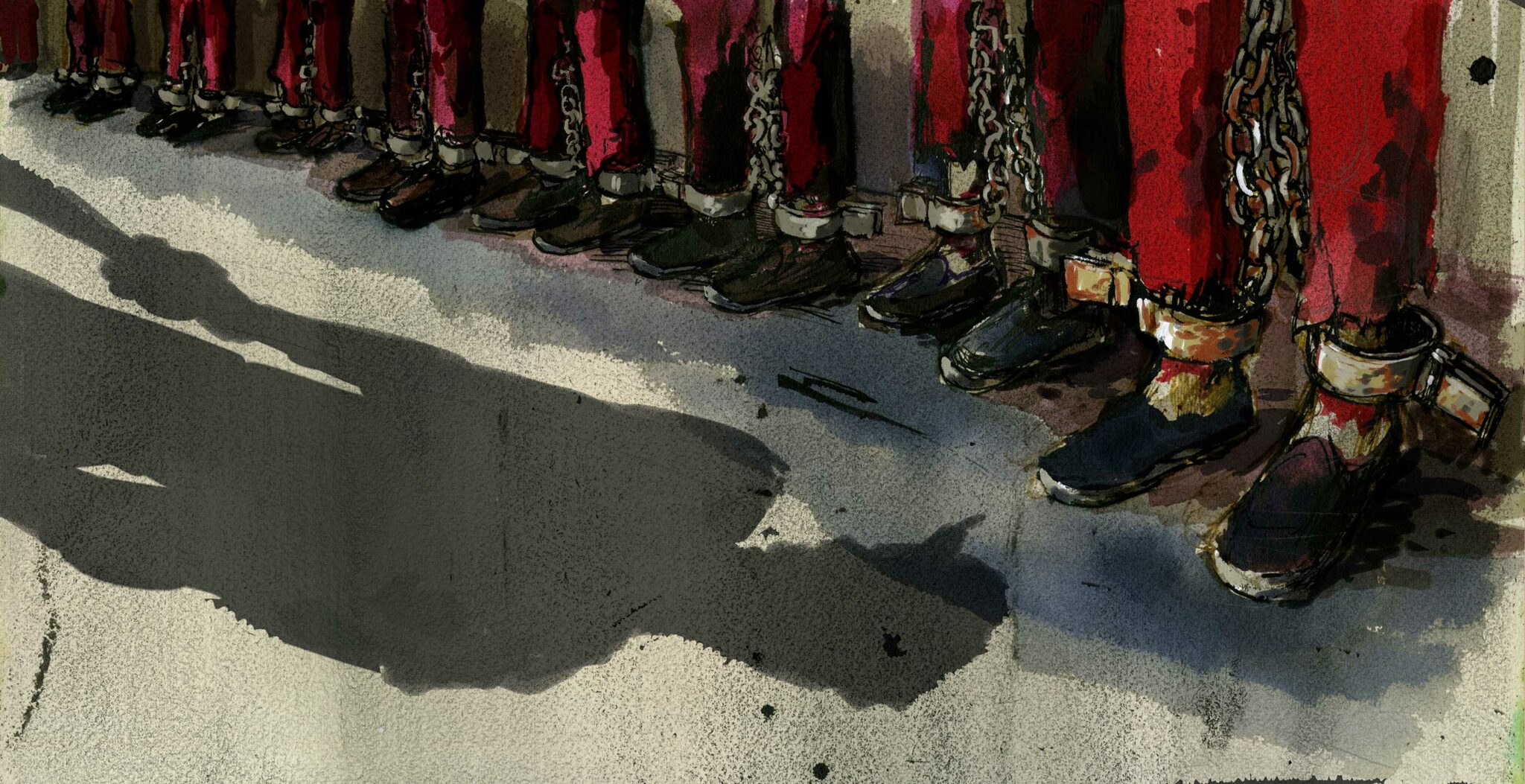Witness accounts of torture and other ill-treatment
Amnesty International interviewed numerous women and men who witnessed the torture or other ill-treatment of other detainees. [[[Amnesty International interviews.]]] Madi told Amnesty he witnessed the torture of a cellmate whom he later learned died from the effects of the torture. Madi said the man was made to sit in a tiger chair in the middle of their cell. The cellmates were made to watch him sit there, restrained and immobilized, for three days, and were expressly forbidden to help him.
He was a [ethnicity redacted]. I can’t remember his name. There are many things I can’t remember [since I left the camp]… [The man] was in our room for more than two months, then he was taken to the doctor – I think he was taken for high blood pressure and because he fainted… As soon as he came back [to our cell] he was made to sit in a tiger chair. [I think the man was being punished for pushing a guard.]… They brought the chair into our room… Yes, we were watching. They told us that if we helped him then we would sit in the chair… It was an iron chair… his arms were cuffed and chained. Legs were chained as well. His body was tied to the back of the chair… Two [cuffs] were locked around his wrists and legs… A rubber thing attached to the ribs to make the person [sit] up straight… at some point we could see his testicles. He would [urinate and defecate] in the chair. He was in the chair for three nights… He died after he [was taken out of the cell]. We found out through [people] in the cell… He didn’t die in front of us. After 72 hours, he was [urinating and defecating]. We told the guards. They said to clean him. His bottom was wounded. His eyes look unconscious… Then [the guards] took him [out of the cell]. [[[Amnesty International interviews.]]]
Timur told Amnesty he witnessed two of his cellmates immobilized in tiger chairs for extended periods. He and the other cellmates were forced to watch and forbidden to provide any assistance:
They used to make people sit in tiger chairs for hours. I saw it with my own eyes. They used to make the person sit in the tiger chair in front of us. They used to bring the chair into our cell if someone was not obedient… It happened twice. The first guy [was immobilized] for 24 hours. He was not allowed to eat or drink. He was taken to the toilet twice… The second guy was made to sit for six hours. [[[Amnesty International interviews.]]]
Zhaina told Amnesty how she and her cellmates were forced to watch others sit in tiger chairs, including one who urinated on herself after being made to sit in the tiger chair for 32 hours: “A female guard used to take us [to another room in camp] to show us how people were suffering… It was in a room [that was originally intended] to keep animals, surrounded by bars. It was dirty… It was like a pound. It was made of bricks with an iron roof… I saw them sitting in the chair.” [[[Amnesty International interviews.]]]
Aibek told Amnesty he saw immobilized people tortured through the use of restraints and exposure to the cold while walking from his cell to the medical clinic in the camp: “I saw how they torture [other people]. One time they set a young lady in a metal chair outside [in January] in thin clothes… [I saw] seven Uyghur men handcuffed [outside] to metal bars and chains on their feet without shoes.” [[[Amnesty International interviews.]]]
Former detainees told Amnesty they witnessed other inmates shackled. [[[Amnesty International interviews.]]] Madina, who also worked in an internment camp, told Amnesty that all detainees in the strict and very strict management categories in the camp she worked in had to be shackled at all times. [[[Amnesty International interviews.]]]
Numerous former detainees witnessed others being beaten, including older detainees. [[[Amnesty International interviews.]]] Beatings were often punishment for moving when they were required to sit still, for not speaking in Mandarin, or for not learning appropriately during classes. Saken told Amnesty that men in his cell were routinely beaten for minor movements.
They ordered us to stay still, to ‘sit tight’, but it was so cold that it was impossible… If you made any motion, they would beat you… You can get beaten for any reason… If someone moved and you tried to explain [to the guard] that the man was innocent then you would be beaten too… I don’t even count the [frequent] slapping and punching as beating… They beat people at night, they took them to the basement… There was a room without cameras… I saw guards dragging motionless men back to [our cell and to the cell across from ours]… I saw four guys [being dragged liked this]… One guy in our cell was beaten unconscious… He had a mental problem… They [took him out of the cell] and beat him until his skin was broken. [[[Amnesty International interviews.]]]
Yerulan told Amnesty that guards routinely beat people as they walked to class, and that a man in his class was taken out of class and beaten for not singing a song properly:
[Name redacted] was beaten, he was an ethnic Uzbek; a Han Chinese [guard] beat him and put him in isolation for 24 hours… He came back with bruises. I was in his cell… and [the guard] would call people who could not recite Chinese content to the door [then the person who was called would stick their hand through the hole in the door] and then cuff them to the door and beat them with an electric baton… I saw [people being beaten] two or three times… I could hear [people being electrocuted] in the hall many more times. [[[Amnesty International interviews.]]]
Zhenis, who worked in a camp, told Amnesty that detainees were regularly beaten in his camp. “Every day someone was taken out [of the class] and beaten, with hands, feet, weapons, and baton,” he said. [[[Amnesty International interviews.]]]
Many former detainees and other witnesses provided Amnesty International with accounts of torture and other ill-treatment that they themselves did not witness. These second-hand accounts were received from other former detainees – usually their cellmates – who were tortured or otherwise ill-treated during interrogations or as punishment. [[[Amnesty International interviews.]]] Former detainees described cellmates being taken to punishment rooms and immobilized in tiger chairs – often for several days – and being beaten during interrogations. [[[Amnesty International interviews.]]] Many returned with visible injuries and stories of torture.
Zhaina told Amnesty that women in her cell were punished by being made to stand still and look at the wall for hours. [[[Amnesty International interviews.]]] Aitugan told Amnesty that another detainees in his cell told him he was taken to a punishment room and hung on the wall with his feet off the ground. [[[Amnesty International interviews.]]] Dariga told Amnesty she spoke with a male former detainee who said his entire cell was put in tiger chairs. [[[Amnesty International interviews.]]] Tajigul told Amnesty other detainees would be taken out of her cell and return with physical injuries:
Some people would disappear for several days. When they came back their bodies were scarred… I know one, because her bed was next to me. She disappeared… [when she came back] her hands were swollen… She said don’t talk to me because there are cameras in the cell… [but she did talk later and said that] two police tortured her. She said she was beaten. They also beat her on the soles of her feet. [[[Amnesty International interviews.]]]
Many detainees said their cellmates appeared to have been punished for very trivial offences. Ibrahim told Amnesty, “In the second facility we had no lessons… we had to sit straight without moving… you can’t even look to the side… one man was taken away [for looking to the side] and came back with swollen feet and legs and he said he was taken and cuffed to a bed and beaten.” [[[Amnesty International interviews.]]]
Journalists and human rights organizations have reported additional witness accounts of torture and other ill-treatment. [[[See John Sudworth, BBC News, “China defends detention of Uighur model in Xinjiang,” 18 August 2020 →; Stephen Gibbs, Daily Mail, “Gang rape, torture and the dreaded red X: Survivor of China’s modern-day concentration camps reveals the horrors behind the walls – and the REAL purpose of terrifying people,” 22 May 2021 →]]]



